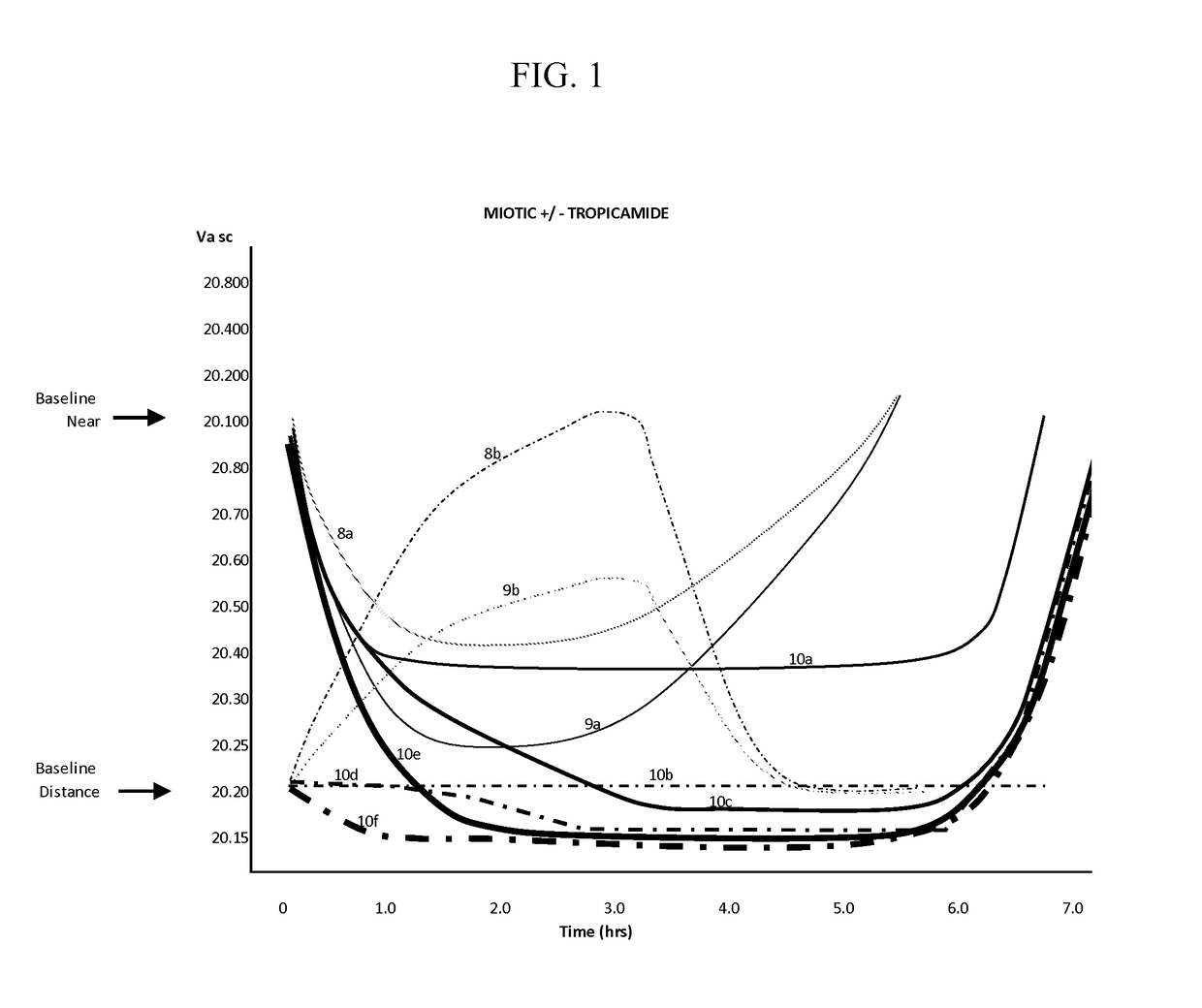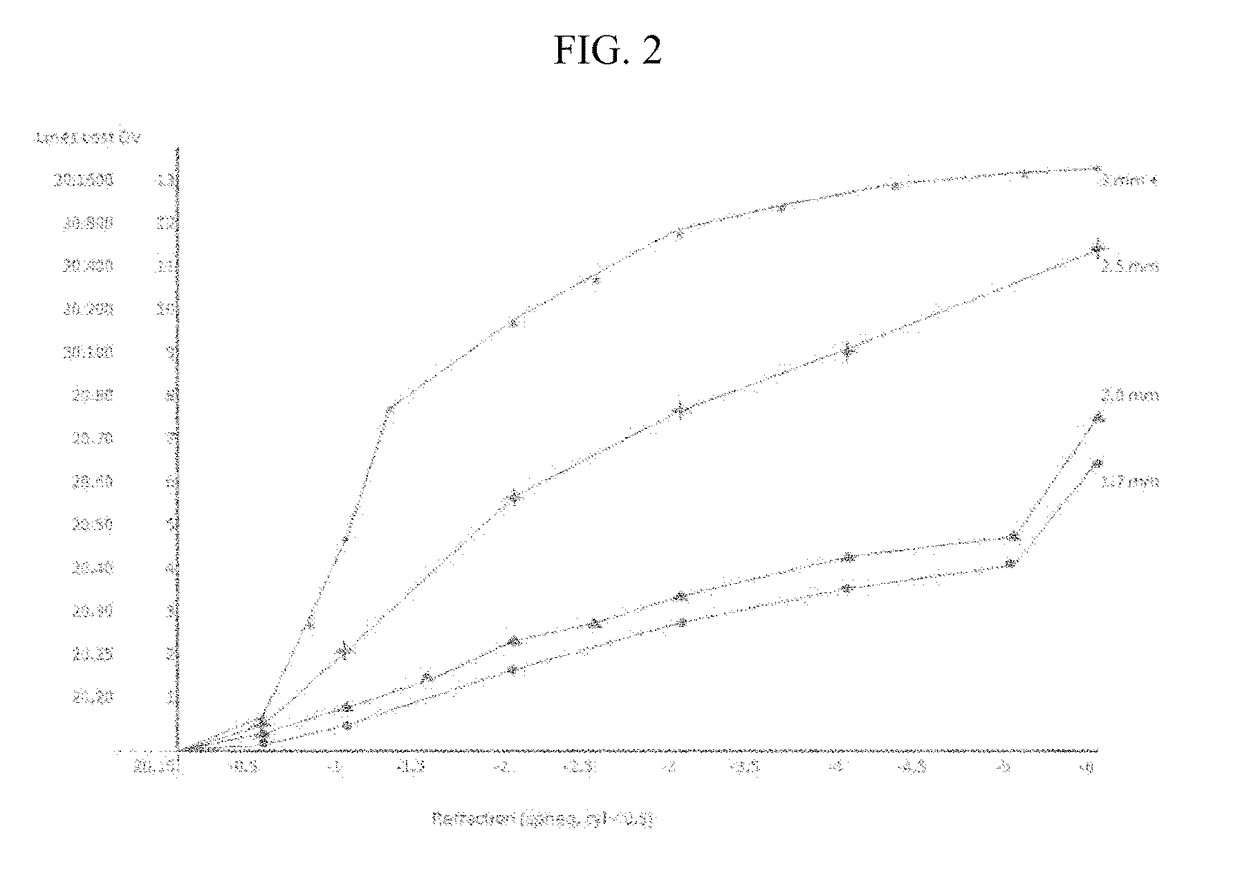Compositions and methods for the treatment of presbyopia
a technology of presbyopia and compositions, applied in the direction of pharmaceutical active ingredients, pharmaceutical delivery mechanisms, organic active ingredients, etc., can solve the problems of insufficient change in normal thickening, limited ability to quickly function at many, and increased curvature of anterior surface of lens, so as to achieve the effect of not reducing distance vision acuity
- Summary
- Abstract
- Description
- Claims
- Application Information
AI Technical Summary
Benefits of technology
Problems solved by technology
Method used
Image
Examples
example 1
Aceclidine on Vision of Subjects Aged 47 to 67 Years
[0163]Table 1 demonstrates the effect on the near focus ability of presbyopic subjects before and after opthalmological administration of a composition containing aceclidine. Each composition included aceclidine in the concentrations indicated and 5.5% w / v HPβCD, 0.75% w / v CMC, 0.25% w / v NaCl and 0.01% w / v BAK. Additionally compositions administered to subjects 4 and 5 included 0.125% w / v tropicamide. As aceclidine is an enantiomer, the clinical effectiveness may vary with different ratios. For the present studies a nearly exact 50:50 ratio of stereoisomers was measured as best determined by polarimetry.
[0164]
TABLE 1Effects of aceclidine on vision of presbyopic patients.Vision BaselinePost Gtt 15″AceclidineR PreL PreR PreL PreR PostL PostR PostL PostEffectDate#Age%DistDistNearNearDistDistNearNear(h)Aug. 21, 20131671.520.2020.3020.6020.6020.2020.2020.1520.159.00Aug. 22, 20132521.520.3020.3020.5020.5020.2520.2520.2520.208.00Aug. 23, ...
example 2
Concentration of Concentration of Aceclidine and Tropicamide
[0166]
TABLE 2Effect of concentration of concentration of aceclidine and tropicamide.#1#2#3#4#5 (OD)#5 (OS)#6#7Brimonidine0.03%0.03%0.03%0.03%0.03%0.03%0.03%Poloxamer 407 5.5%HPBCD 5.5% 5.5% 5.5% 5.5% 5.5% 5.5% 5.5%Aceclidine 1.5% 1.5%0.75% 1.1% 1.1% 1.1% 1.1% 1.1%Tropicamide0.014% 0.021% 0.028% 0.042% 0.062% NaCl0.25%0.25%0.25%0.25%0.25%0.25%0.25%0.25%CMC0.75%0.75%0.75%0.75%0.75%0.75%0.75%0.75%BAK 0.1% 0.1% 0.1% 0.1% 0.1% 0.1% 0.1% 0.1%Redness (15 m)3+ 1 0.50.50000Redness (30 m)1.50.50.250.250000Brow Ache2+ 2+ 20.50.50.00.00.0(60 m)Stinging (10 m)2 2 0.500000BD-OD20.2020.2020.2020.2020.2020.2020.2020.20BD-OS20.2520.2520.2520.2520.2520.2520.2520.25BN-OD8 pt 8 pt 8 pt 8 pt 8 pt 8 pt 8 pt 8 pt BN-OS7 pt 7 pt 7 pt 7 pt 7 pt 7 pt 7 pt 7 pt BP-photopic3 mm3 mm3 mm3 mm3 mm3 mm3 mm3 mmBP-mesopic5 mm5 mm5 mm5 mm5 mm5 mm5 mm5 mmMiosis start (m)15 15 151515151515Miosis (OU)1.63 mm 1.63 mm 2.0-2.5 mm 1.63 mm 1.63 mm 1.63 mm ...
example 3
Concentration of Aceclidine, Brimonidine, Guanfacine, Fadolmidine, Tropicamide and Additives
[0173]
TABLE 3Effect of concentration of aceclidine, brimonidine, guanfacine,fadolmidine, tropicamide and additives.AB2TAB4TAB6TAB11TAB12TPROPH13Aceclidine1.551.551.551.551.851.55Brimonidine0.0370.0370.0370.037Fadolmidine0.037Guanfacine0.037HPBCD5.55.55.55.55.55Tropicamide0.0430.0430.0430.0430.0420.043CMC*0.0750.0750.0750.0750.0750.075NaCl0.0250.0250.0250.0250.0250.025BAK0.010.010.010.010.010.01Glycerin0.10.10.1Poloxamer0.10.05188Polyoxyl 400.05stearatepH6.57.57.57.57.07.5nasal000000congestionstinging0.7501.53.501.5initialstinging,0.500wash003 minoutredness001D / C11initialredness000D / C0015 minwhitening000D / C1.51.5pain000D / C00vision near20.3020.1520.15D / C20.1520.15vision 20.2020.2020.20D / C20.2020.20distanceonset (min)201216D / C1216duration 5.57.57.5D / C7.57.5(hrs)colorclearyellowyellowyellowyellowyellowOVERALL2.53.93.8043.9*1% = 2,500 cps
[0174]All percentages are w / v. Scores for nasal congestion, ...
PUM
| Property | Measurement | Unit |
|---|---|---|
| distance vision | aaaaa | aaaaa |
| distance | aaaaa | aaaaa |
| distance vision | aaaaa | aaaaa |
Abstract
Description
Claims
Application Information
 Login to View More
Login to View More - R&D
- Intellectual Property
- Life Sciences
- Materials
- Tech Scout
- Unparalleled Data Quality
- Higher Quality Content
- 60% Fewer Hallucinations
Browse by: Latest US Patents, China's latest patents, Technical Efficacy Thesaurus, Application Domain, Technology Topic, Popular Technical Reports.
© 2025 PatSnap. All rights reserved.Legal|Privacy policy|Modern Slavery Act Transparency Statement|Sitemap|About US| Contact US: help@patsnap.com


